How to learn Korean by yourself
We all dream of being able to watch our K-dramas without relying on subtitles, but in reality, we only understand annyeonghaseyo and saranghae. So here are some free resources and tips on how to learn Korean by yourself.
Table of Contents
1. Introduction to Hangul

Image credit: ibmoon Kim via Unsplash
If you don’t already known, the Korean language uses its own writing system called 한글 (Hangul). To master the language, you must learn and recognise the Hangul characters.

Image credit: Mathew Schwartz via Unsplash
Hangul, also known as the Korean alphabet, is the official writing system created by Sejong the Great in the 1400s during Joseon Dynasty.
In the past, Korean people had to write in Chinese and speak in Korean. It was especially challenging for the lower class people when they wanted to write letters and records as they couldn’t afford to study Chinese.
Therefore, Hangul was introduced to standardise the use of the Korean language in both writing and speaking and improve the citizens’ literacy.
10 vowels and 14 consonants

Hangul consists of 24 basic letters that you can mix and match to form different Korean words. Unlike the English language, Hangul consists of 10 vowels and 14 consonants.
In Hangul, there are 10 main vowels that you will need to recognise, and you can combine up to 3 different vowels in a single word.
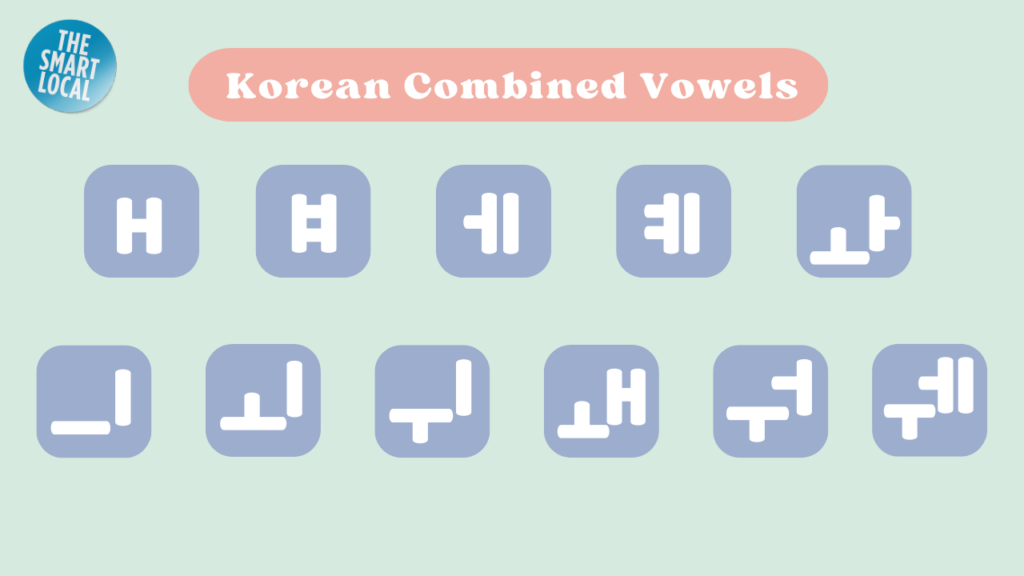
For example, you can combine 2 vowels “ㅏ” (a) and “ㅣ” (i) to form “ㅐ” (ae) or 3 vowels “ㅗ” (o), “ㅏ” (a) and “ㅣ” (i) to form “ㅙ” (wae).
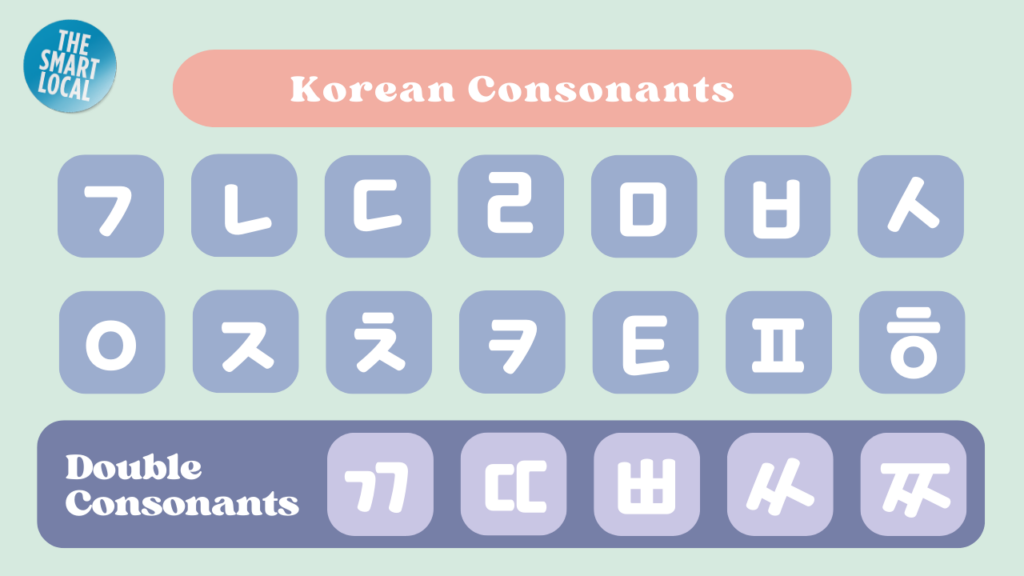
There are 14 consonants in Hangul, and 5 of them can be used as double consonants. The 5 consonants “ㄱ”, “ㄷ”, “ㅂ”, “ㅅ” and “ㅈ” can be doubled and used as “ㄲ”, “ㄸ”, “ㅃ”, “ㅆ” and “ㅉ” respectively.
How to form a Korean word
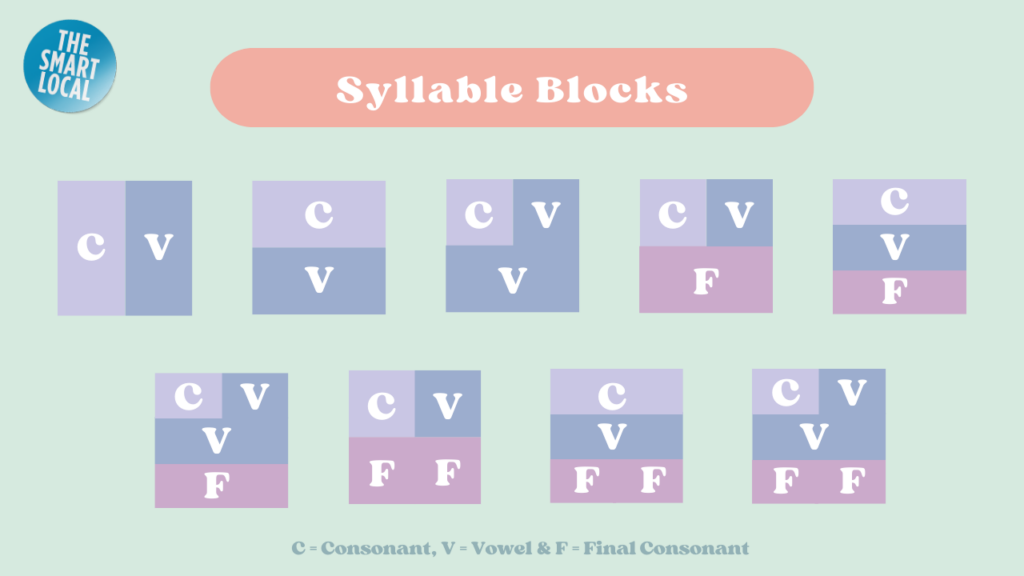
Now that you can identify the 24 basic Hangul letters, you can start forming your Korean words and sentences.
The Korean language uses a particular writing system which includes forming syllable blocks. These syllable blocks can be created in many different ways.
– 3 main types of syllable blocks –
1. Forming a word by putting 1 consonant and 1 vowel side by side
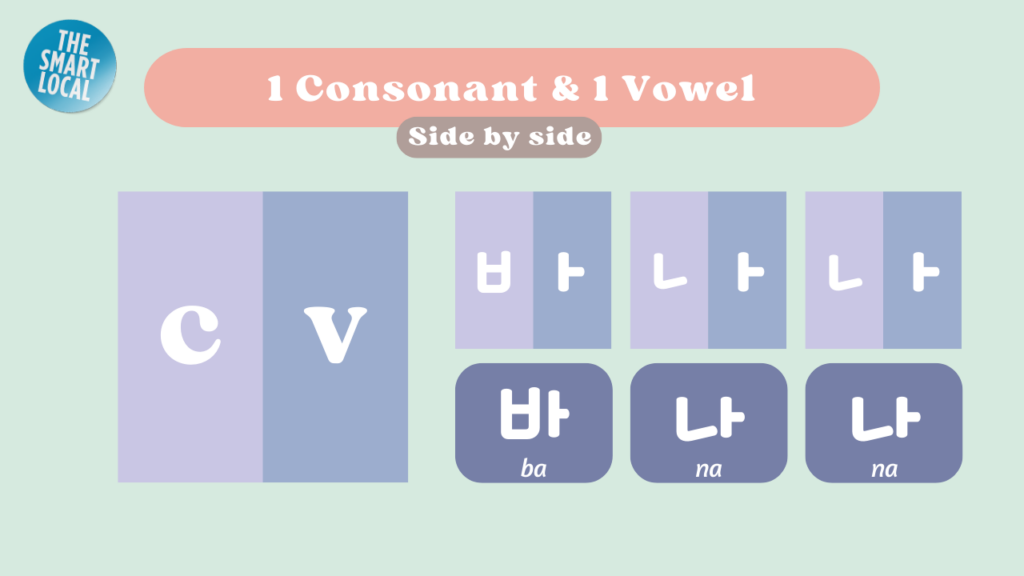
One of the simplest ways to form a word is by putting 1 consonant and 1 vowel side by side.
This type of syllable block allows you to form words such as 바나나 (ba-na-na; banana). By putting the consonant “ㅂ” on the left and the vowel “ㅏ” on the right, you’ll get the word “바” (ba).
2. Forming a word by stacking 1 consonant and 1 vowel
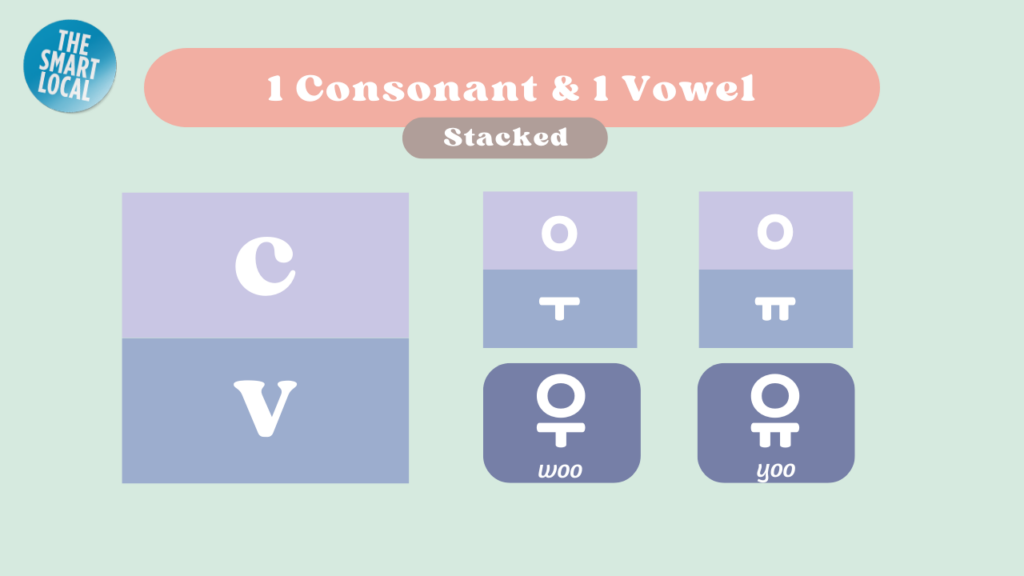
Other than placing the consonant beside the vowel, you can form another type of syllable block by stacking the consonant above the vowel.
This allows you to form words such as 우유 (woo-yoo; milk) by stacking the consonant “ㅇ” above the vowel “ㅜ” to form the word “우” (woo).
3. Forming a word using 1 consonant, 1 vowel and 1 final consonant
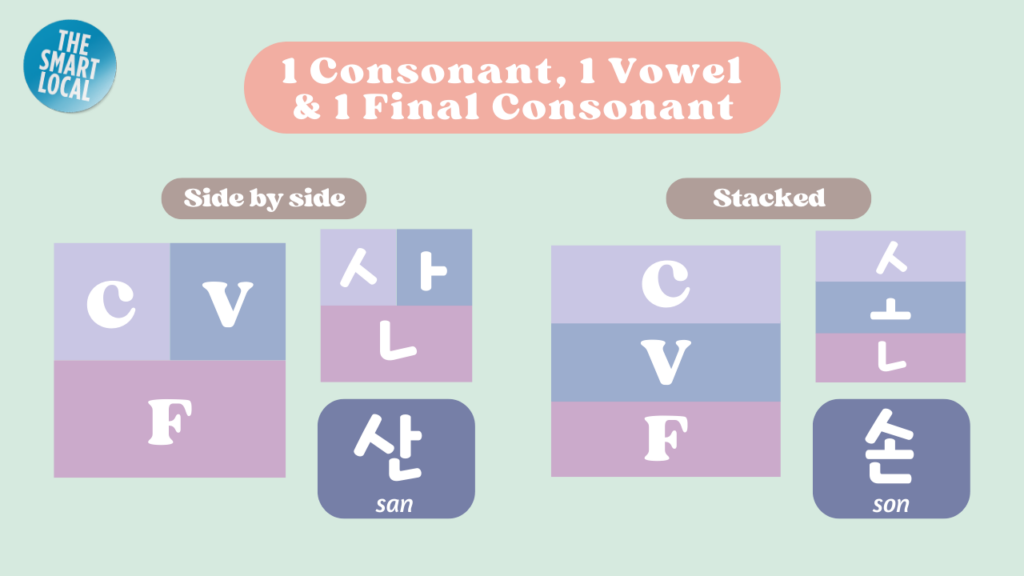
Unlike the previously mentioned syllable blocks, this one includes a final consonant.
A final consonant is also known as the 받침 (batchim). It is placed at the bottom of a syllable block and pronounced at the end of a word.
For example, you combine the first consonant “ㅅ” with the vowel “ㅏ” and end it with the final consonant “ㄴ” to form words such as 산 (san; mountain).
Another example would be 손 (son; hand), where you stack the first consonant “ㅅ” above the vowel “ㅗ” and end it with a final consonant “ㄴ”.
2. Practice Korean pronunciation

Video adapted from: 아는형님 Knowingbros via YouTube
Each vowel and consonant has its unique sound, and it is essential to learn to pronounce them correctly.
Pronouncing Korean words may seem challenging. But once you break the word down into vowels and consonants, the pronunciation is very straightforward.
Vowels
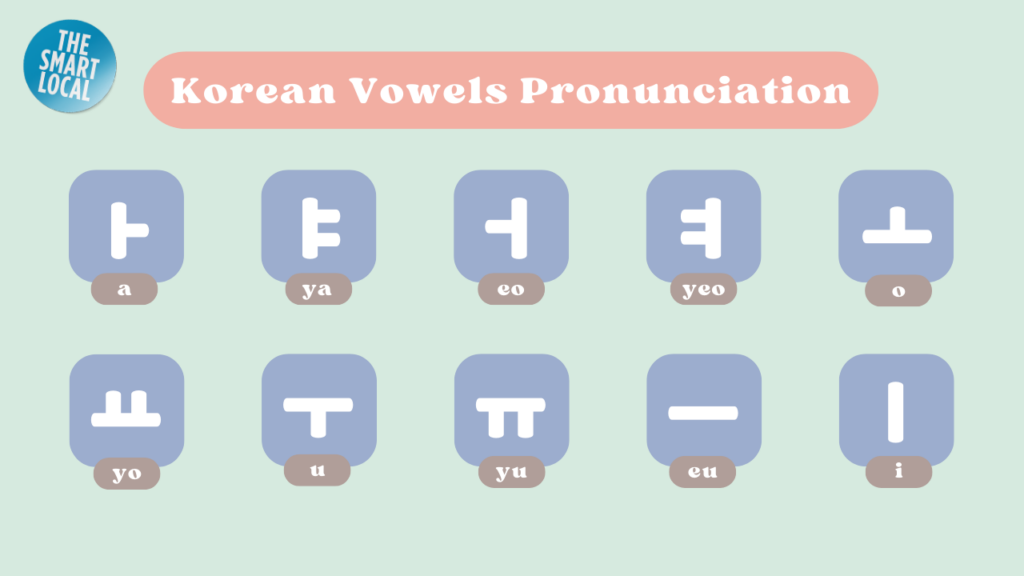
When there are 2 or 3 vowels in a word, you combine them from left to right, then top to bottom.
For example, when reading the word 쥐 (jwi; rat), you read the consonant “ㅈ” (j) first, then the 2 vowels “ㅜ” (u) and “ㅣ” (i).
Consonants
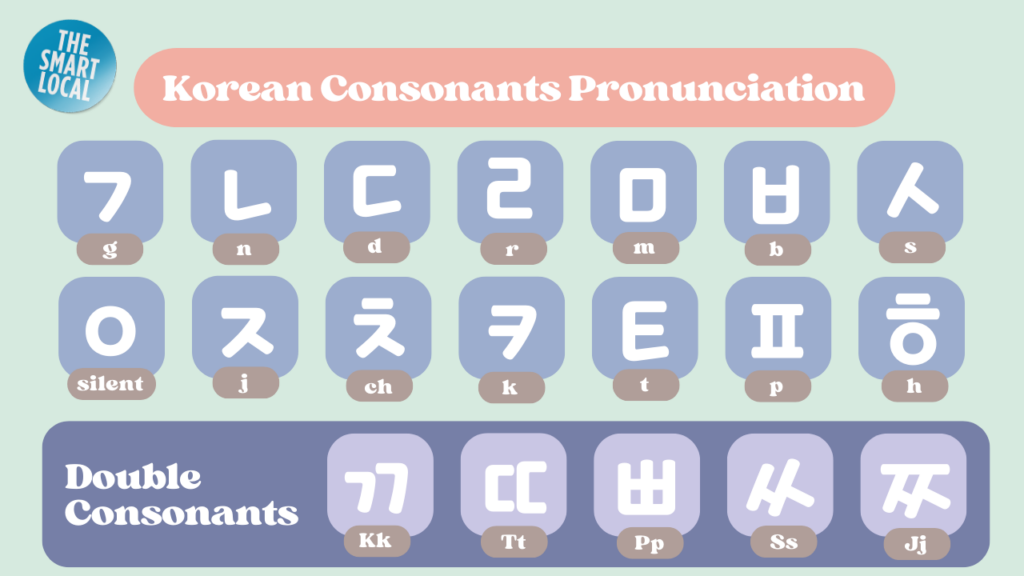
When pronouncing a word that starts with double consonants such as ‘ㅃ’, ‘ㅉ’, ‘ㄸ’, ‘ㄲ’ and ‘ㅆ’, you should put more stress on the pronunciation.
An example would be 예쁘다 (ye-ppeu-da; pretty), where you emphasise the “ㅃ” to create a “ppeu” sound.
Another thing to note is that the consonant “ㅇ” is silent. When reading words such as 여자 (yeo-ja; woman), you should only pronounce the “ㅕ” (yeo) sound.
Final consonants
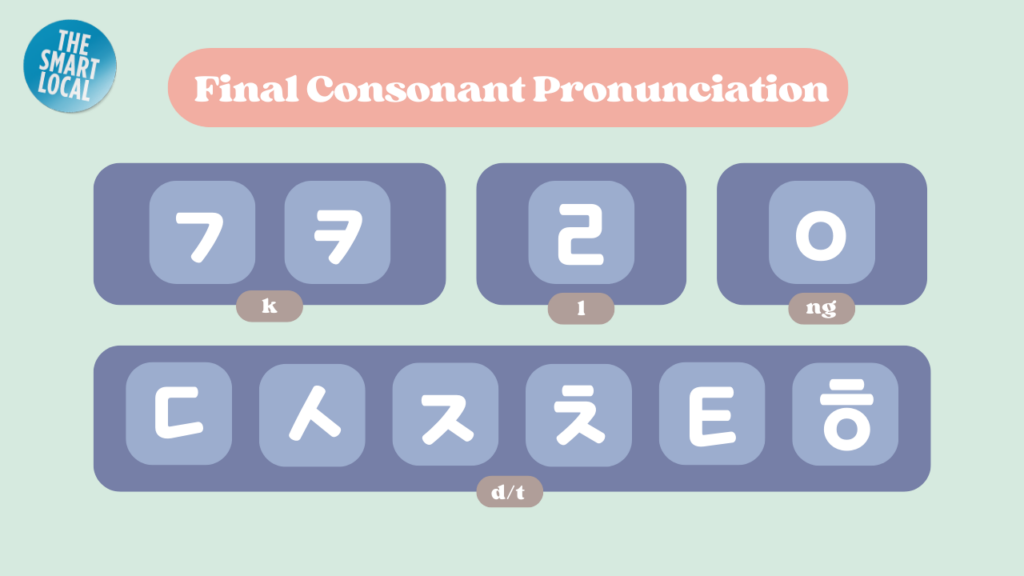
When consonants are used as the final consonant, some of them will have a change in sound.
When using final consonants such as “ㄴ”, “ㅁ”, “ㅂ” and “ㅍ”, pronounce them as is. However, consonants like “ㄱ” and “ㅋ” produce the “k” sound when used as a final consonant.
Consonants like “ㄹ” will be pronounced with an “l” sound instead of “r”, and “ㅇ” will be pronounced with an “ng” sound.
Other consonants such as “ㅅ”, “ㅈ”, “ㅊ”, “ㅌ” and “ㅎ”, when used as a final consonant, will produce the “d” or “t” sound instead.
If a final consonant is accompanied by the “ㅇ” vowel in the following word, the final consonant sound will be brought over to replace the silent “ㅇ”. For example, 만원 (man-won; ten thousand won) will be pronounced ma-nwon instead.
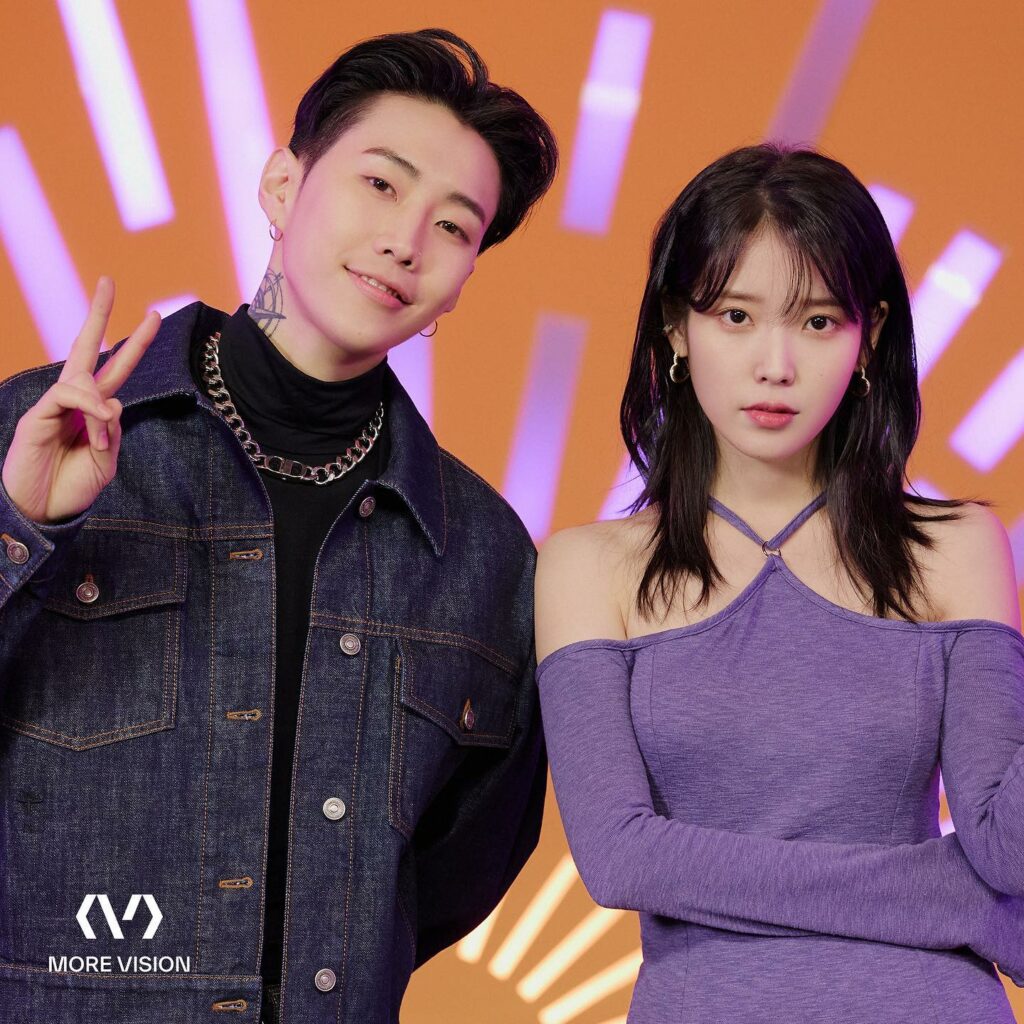
Image credit: @moresojuplease via Instagram
Fun fact: Jay Park’s hit song featuring IU, Ganadara, is inspired by the Hangul writing system.
The chorus featured lyrics that go ga-na-da-ra-ma-ba-sa, which is in the sequence of the hangul alphabet, 가 – 나 – 다 – 라 – 마 – 바 – 사.
3. Pick up Korean grammar

Image credit: cottonbro via Pexels
Like English, there are Korean grammar rules that you will need to know and apply when speaking or forming sentences.
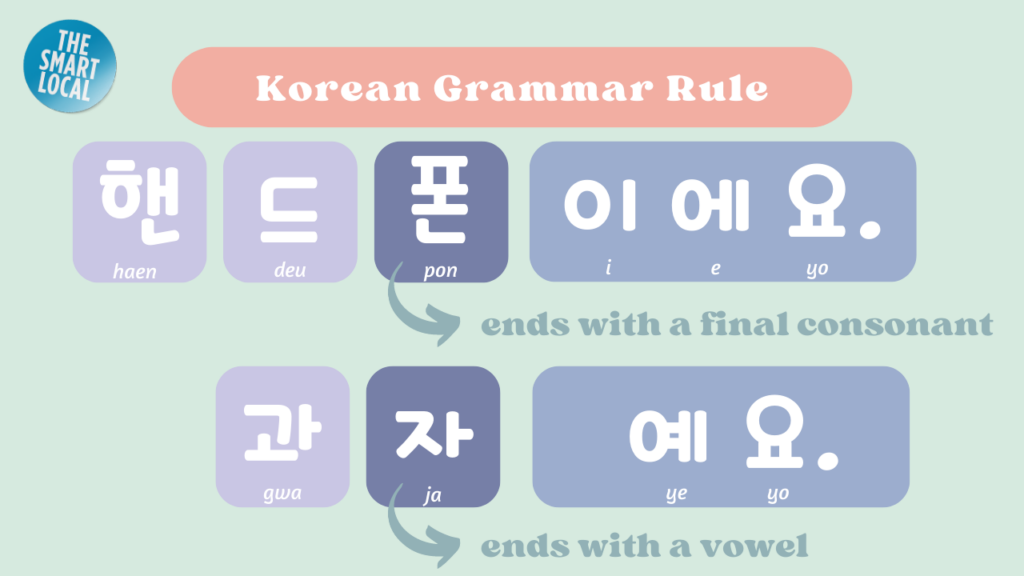
One of the most commonly misused Korean grammar rule is 이에요 (i-e-yo) and 예요 (ye-yo). 이에요 (i-e-yo) is used when the previous word ends with a final consonant, while 예요 (ye-yo) is used when the previous word ends with a vowel.
For example, “핸드폰 이에요” (haen-deu-pon-i-e-yo; “It’s a phone”) and “과자 예요” (gwa-ja-ye-yo; “It’s a snack”).
Another common Korean grammar mistake is the 을 (eul) and 를 (reul). 을 (eul) is used when the previous word ends with a final consonant and 를 (reul) is used when the previous word ends with a vowel.
4. Formal & informal speech
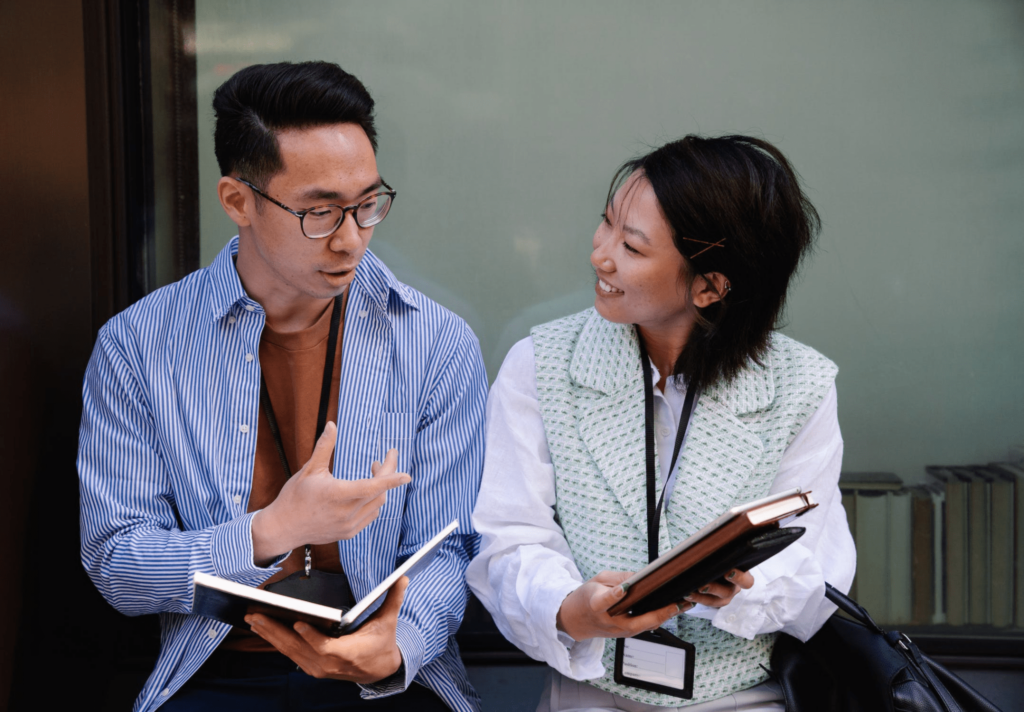
Image credit: Felicity Tai via Pexels
In Korea, it is crucial to know when to use formal speech and when you can use informal speech so that you won’t appear rude and offend people when you speak.
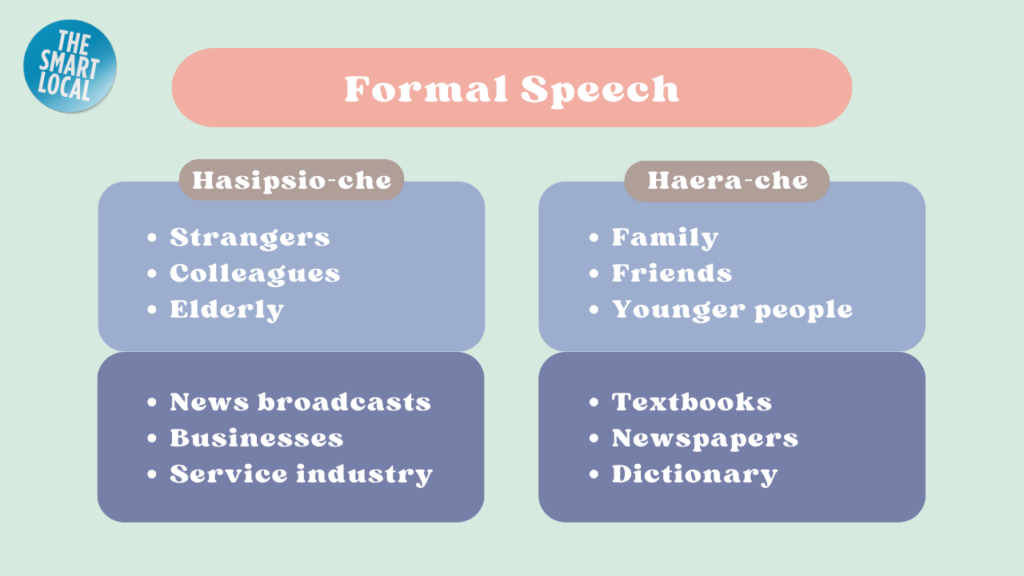
The 2 most commonly used formal speeches in Korea are 하십시오체 (hasipsio-chae) and 해라체 (haera-chae).
Hasipsio-chae speech is usually used when speaking to elders or on news broadcasts. While haera-chae speech is more casual compared and utilised between people of similar ranks or ages.

Other than the 2 formal speeches, the most commonly used informal speeches in Korea are known as the 해요체 (haeyo-chae) and 해체 (hae-chae).
The haeyo-chae speech is informal yet polite. It is used in day-to-day conversations with people like your teachers and parents. While, hae-che speech, also known as 반말 (banmal), is the most casual way of speech and is usually used between your close friends or to younger people.
5. Korean sentence structure
5a. Subject-Object-Verb sentence
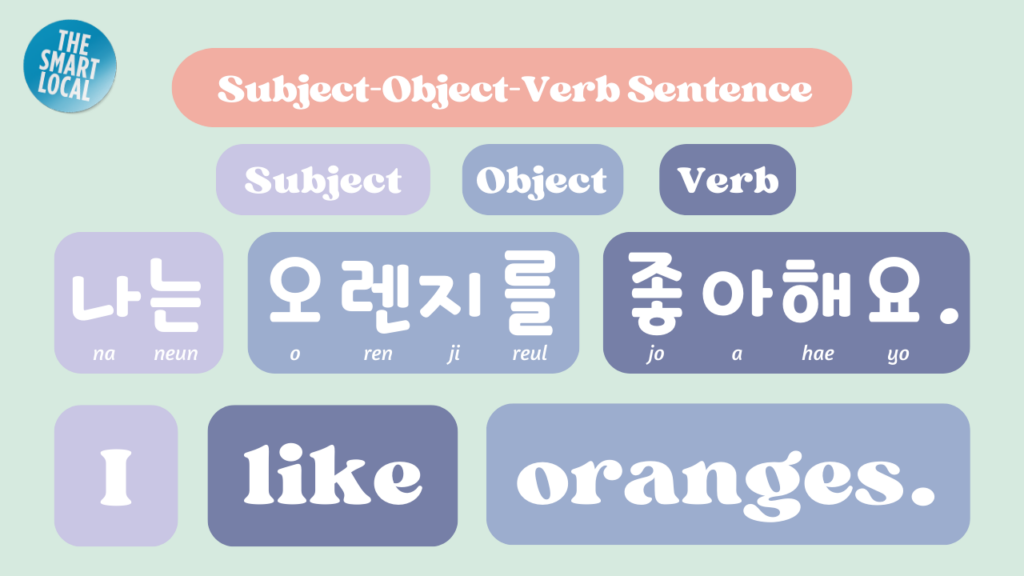
There are multiple sentence structures that you should follow when forming sentences. Here are 3 main ones.
The most basic Korean sentence structure is the Subject-Object-Verb sentence. It differs from English as the object will come before the verb instead.
An example is “I like oranges”, where the sentence starts with a subject, then a verb and ends with an object.
In Korean, the sentence “나는 오렌지를 좋아해요.” (na-neun-o-ren-ji-reul-jo-a-hae-yo), starts with a subject “나는” (na-neun) then the object “오렌지를” (o-ren-ji-reul) and ends with the verb “좋아해요” (jo-a-hae-yo) – literally, “I orange like”.
5b. Subject-Verb sentence

The Subject-Verb sentence structure is most used in sentences that don’t require an object.
When saying “I want to cook.”, your sentence should start with the subject “나는” (na-neun) and end with the verb “요리하고 싶다” (yo-ri-ha-go-sip-da).
5c. Subject-Adjective sentence
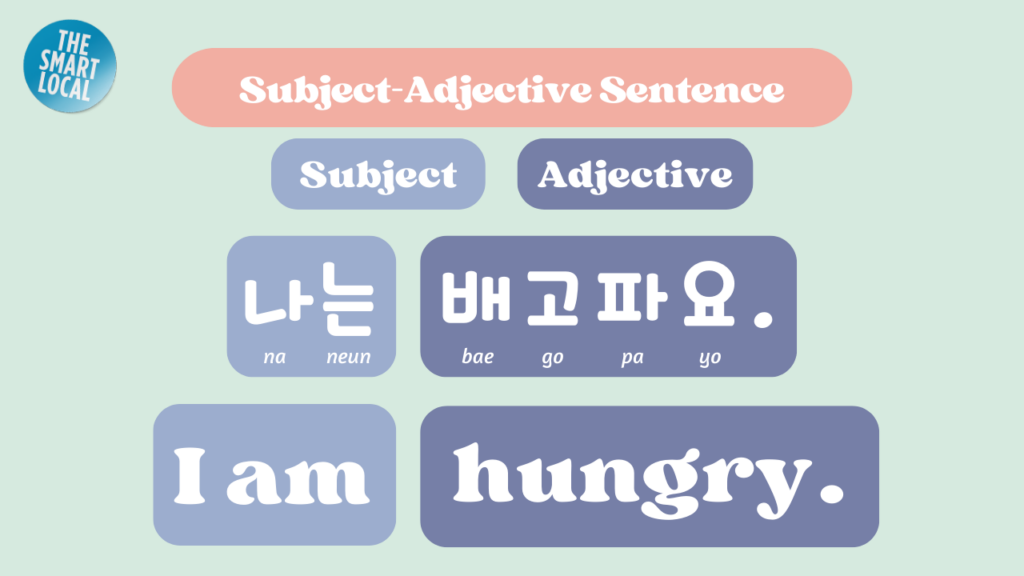
Another basic Korean sentence structure is the Subject-Adjective sentence structure, which is used to express your feelings.
For example, the sentence “I am hungry” starts with the subject and ends with an adjective.
In Korean, the sentence structure is similar, starting first with the subject “나는” (na-neun), then ending with the adjective “배고파요” (bae-go-pa-yo).
6. Numbers in Korean

Video adapted from: STUDIO CHOOM [스튜디오 춤] via YouTube
Korea uses 2 different sets of numbers, the Sino-Korean numbers and Native Korean numbers. The numbers have varioous uses in different situations.
Sino-Korean numbers

The Sino-Korean numbers are also known as the Chinese system of counting and sound very similar to Chinese.
These numbers are usually used for things such as dates, money, minutes, addresses and phone numbers, and for numbers greater than 100.
Native Korean number
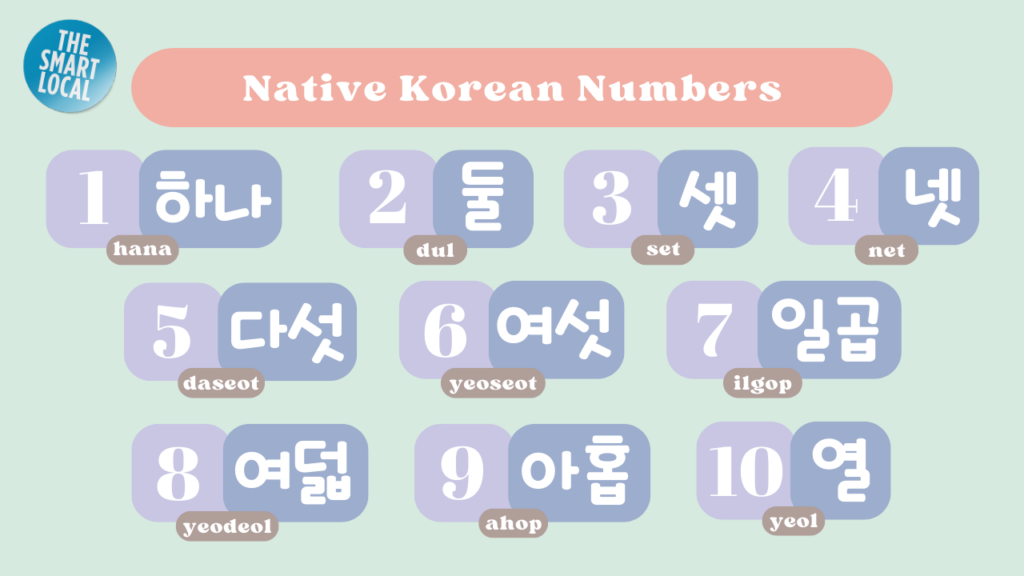
The Native Korean numbers are generally used in counting people, hours, things and ages.
They are also only used to count up to 99 and will be counted in Sino-Korean numbers from 100 onwards.
When the numbers are accompanied by a counting unit, they will be pronounced differently. Numbers 1 to 4 will be read as han, du, se and ne instead of hana, dul, set and net.
For example, one bottle will be read as han-byeong instead of hana-byeong and four books will be read as ne-kwon instead of net-kwon.
7. Korean counting units
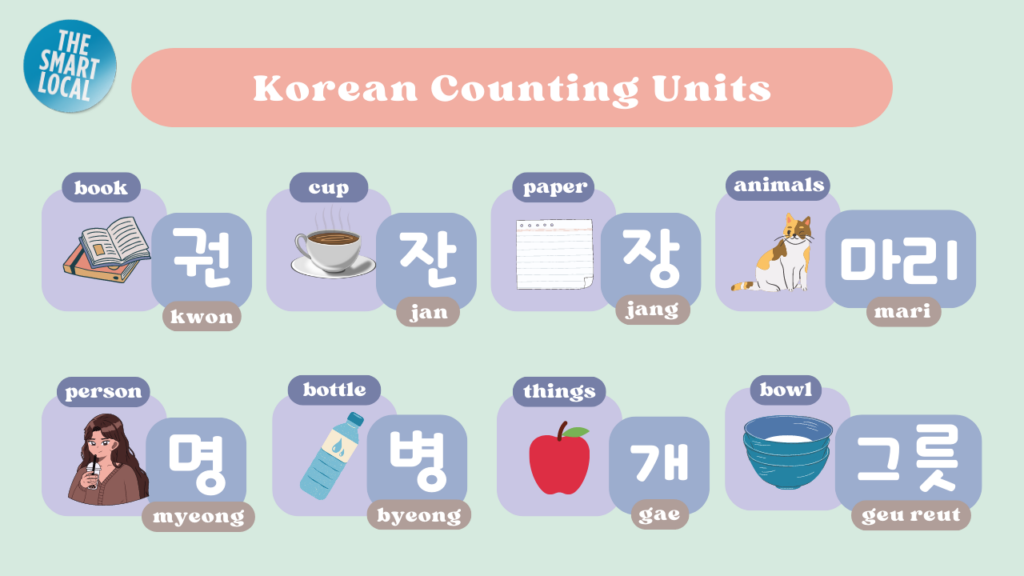
In the Korean language, there are many counting units, and the most common one is 개 (gae) which is used to calculate things like apples and chairs.
Some other examples include 벌 (beol) to count clothing and 대 (dae) to count machinery or electronics.
8. Watch Korean dramas & variety shows

Image credit: Mollie Sivaram via Unsplash
Learning Korean by yourself may be challenging and tedious. But the great news is that watching Korean dramas and variety shows can help you improve your Korean language skills, and they expose you to the language and make you familiarise yourself with the use of specific vocabulary and phrases.
8a. Korean dramas

Image credit: @sbsdrama.official via Instagram
Watching K-dramas is a good way for beginners to start learning Korean, as the dialogue is usually more precise and delivered more accurately.
Note that conversations in K-dramas may have frequent changes between formal and informal speech, which might get confusing.
For beginners, it is good to start on non-historical dramas and dramas that do not have complicated terms as the lines may be challenging to catch and comprehend.
8b. Variety shows

Image adapted from: @sbs_runningman_sbs via Instagram
If you need some laughter in life, watching Korean variety shows is a good way to lift up the mood while exposing you to everyday conversations.
You can usually find hangul commentary captions on variety shows, which will help you recognise Korean characters too.
Note that conversations in variety shows may be a little fast to catch and frequently use slang words that may be foreign to you.
9. Free learning resources

Image credit: Avel Chuklanov via Unsplash
Now that you have a basic understanding of the language, you can refer to the following free learning resources to dive deeper into the world of the Korean language.
– Podcasts –
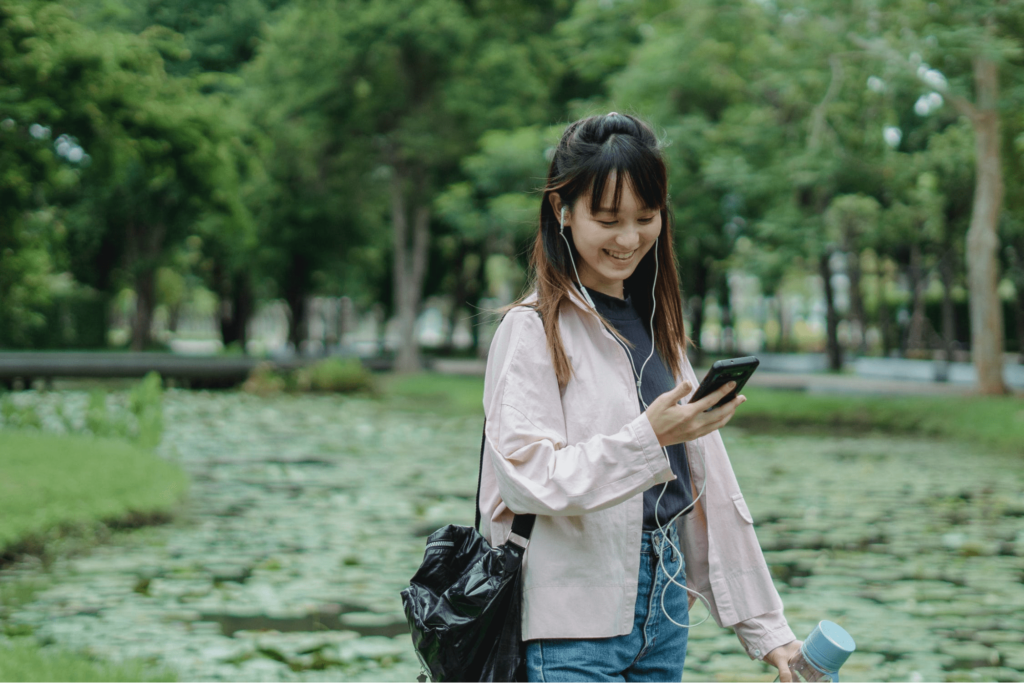
Image credit: Zen Chung via Pexels
To understand Korean to the level where you’re able to watch your dramas without subtitles, you will need to do more listening.
Listening to podcasts is one of the most convenient ways to learn Korean, as you can do it anytime and anywhere, especially on commutes.
1. Real Life Korean Conversations For Beginners
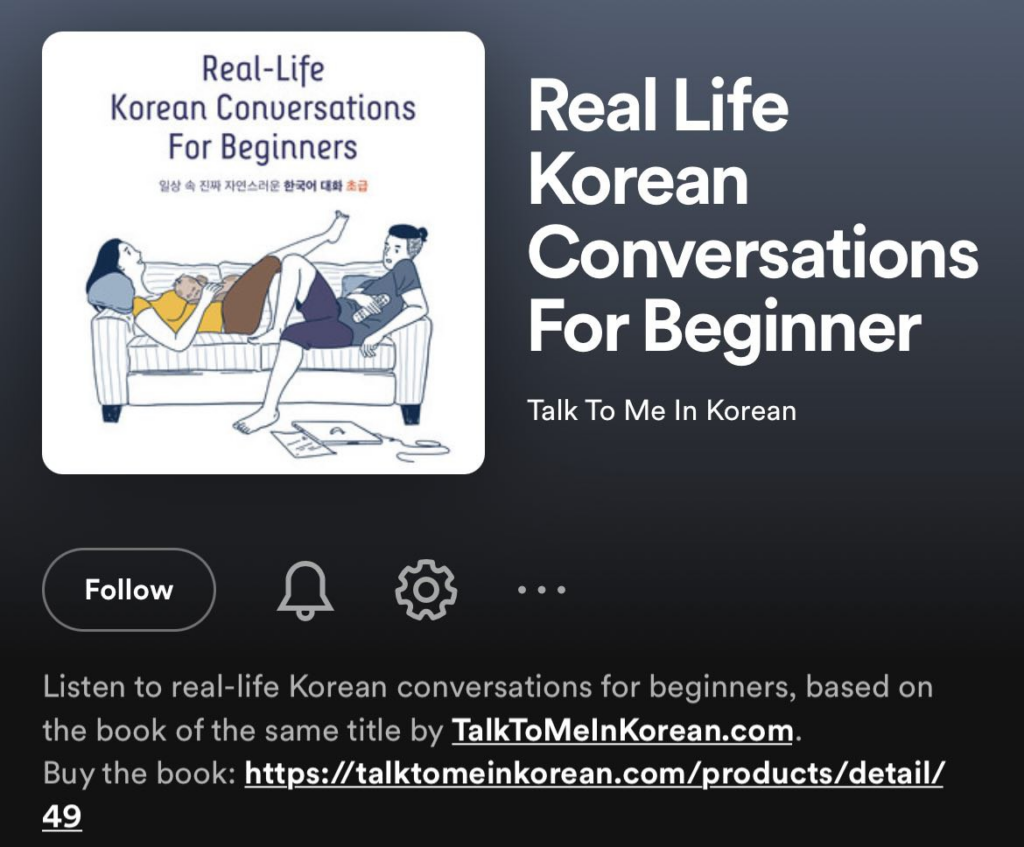
Image adapted from: Spotify
This podcast is excellent for beginners as the conversations are spoken at a slower pace and with more precise pronunciation.
It also provides English translation immediately after the Korean conversation, so you can learn new vocabulary too.
Listen to the Real Life Korean Conversations For Beginners podcast on Spotify.
2. IYAGI – Natural Korean Conversations
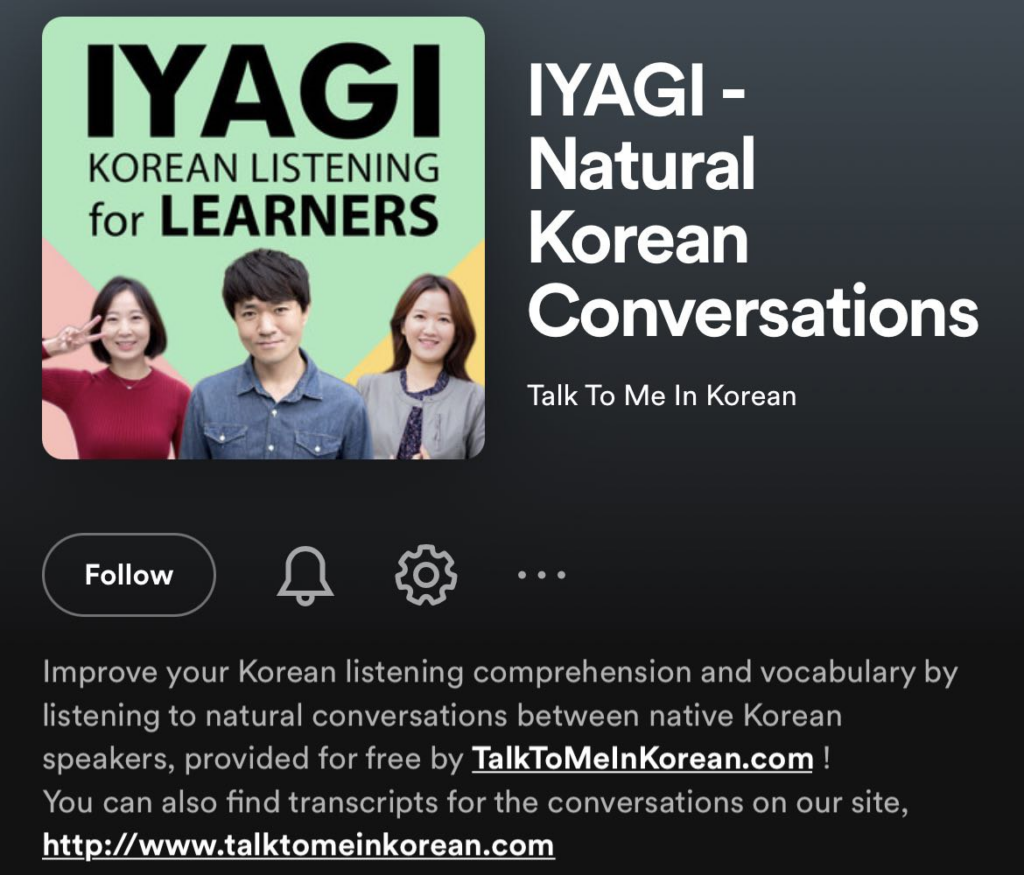
Image adapted from: Spotify
If you’ve reached a certain level of fluency in Korean, you can listen to podcasts such as IYAGI – Natural Korean Conversations, which allows you to hear natural conversations on different topics.
The podcast is spoken entirely in Korean, so if you find words or phrases that are hard to understand, you can visit their website for the transcript and translation.
You can listen to IYAGI – Natural Korean Conversations on Spotify.
3. Talk To Me In Korean – Core Korean Grammar
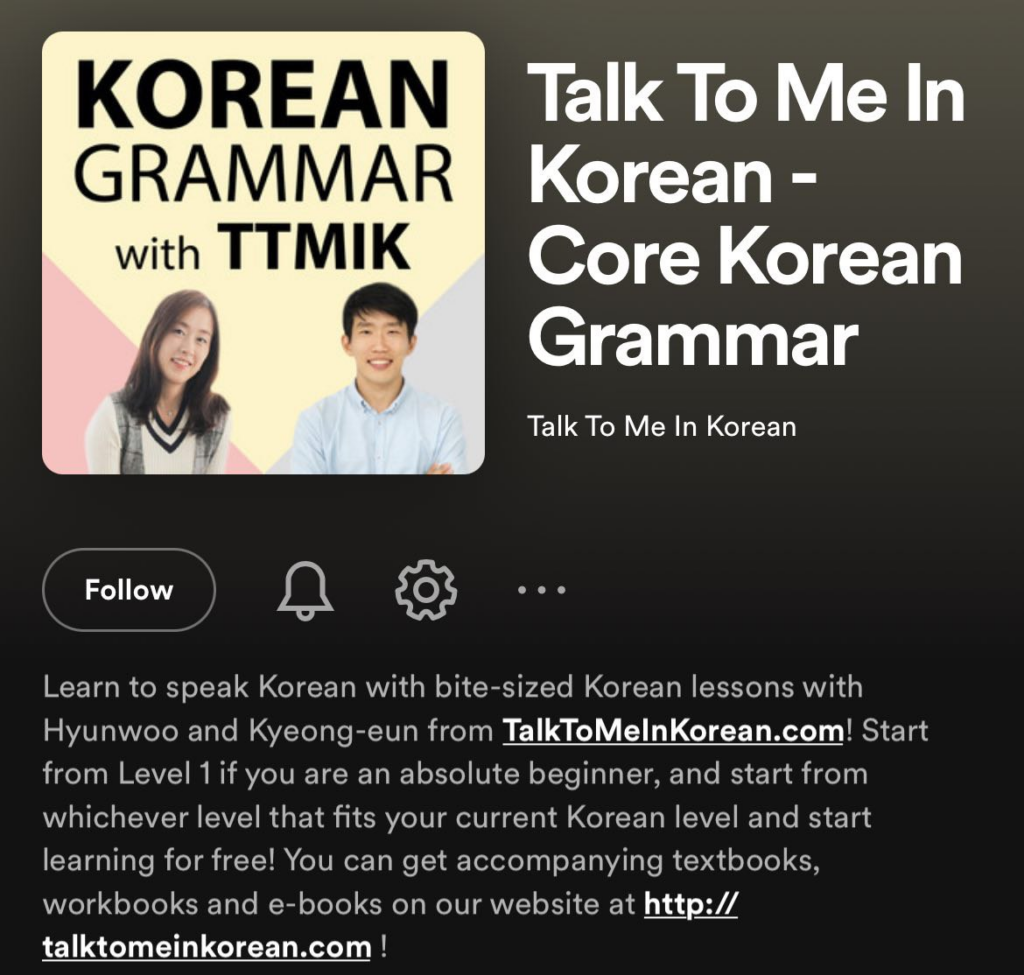
Image adapted from: Spotify
If you want to improve your grammar, you can listen to this podcast which focuses on Korean grammar.
This podcast gives examples and an English explanation of different grammar rules and how using the wrong grammar will affect the meaning of the sentences.
You can listen to Talk To Me In Korean – Core Korean Grammar on Spotify.
– Online resources –
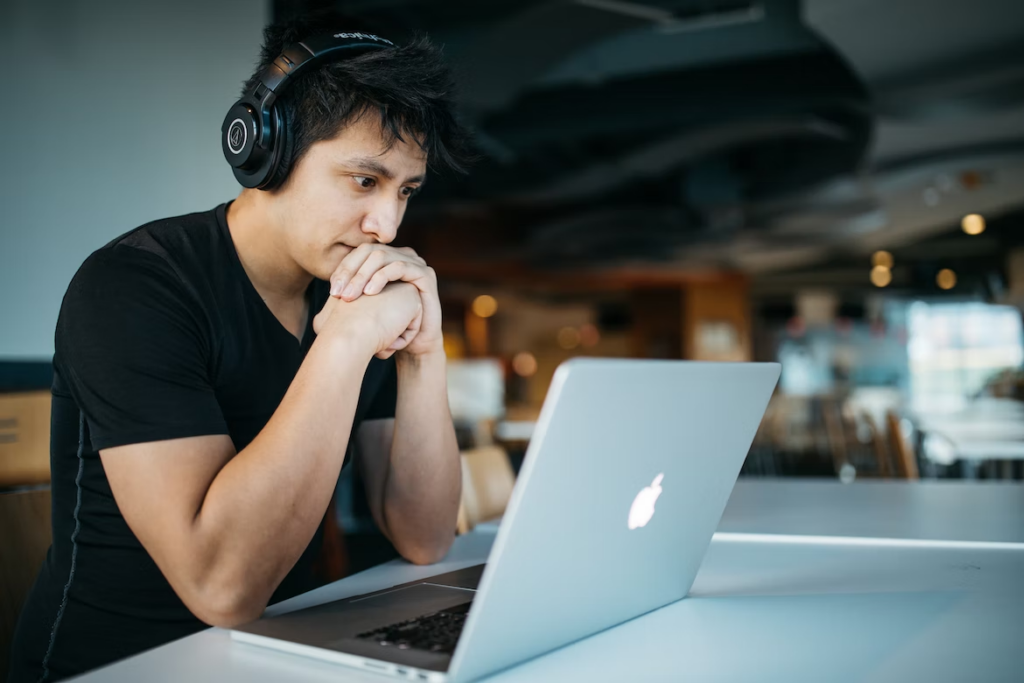
Image credit: Wes Hicks via Unsplash
It is hard to find Korean textbooks and workbooks, and Korean language lessons can be expensive. So here are some free learning materials and online courses to download and attend.
1. Coursera

Image adapted from: Coursera
Coursera offers free Korean courses from top Korean universities such as Yonsei University and Sungkyunkwan University.
The courses include lessons and free learning materials that you can download. You can also pay a fee to access graded assignments and a certificate upon completion.
Look at the Korean courses offered on Coursera.
2. Talk To Me In Korean
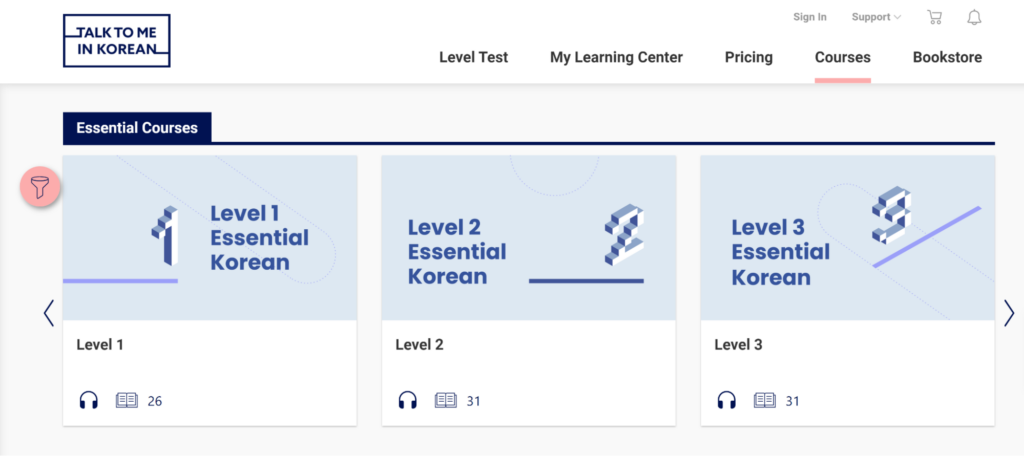
Image adapted from: Talk To Me In Korean
Talk To Me In Korean has a basic package which provides free essential Korean courses, PDF lesson notes and certificates for specific courses.
If you wish to gain access to sample dialogue videos, comprehension quizzes and premium lessons, you can choose to sign up for their premium package instead.
Look at the courses offered on Talk To Me In Korean.
3. Online King Sejong Institute
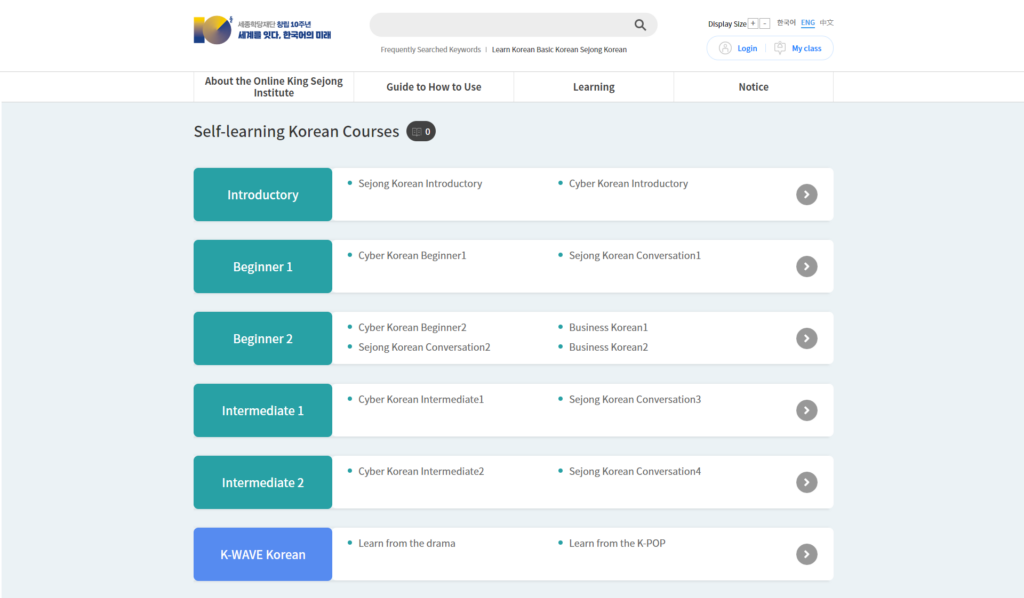
Image adapted from: Online King Sejong Institute
Online King Sejong Institute offers Korean courses – from introductory to intermediate levels – that cater to everyone.
If you are looking for something fun, apply for the K-WAVE Korean course to learn Korean through K-dramas and K-pop.
Look at the courses offered on Online King Sejong Institute.
– Apps you can download to learn Korean –

Image credit: Airam Dato-on via Unsplash
If you find learning from textbooks boring, opt for these free apps to learn Korean instead.
These apps have nicely drawn graphics, mini-games and speed quizzes for you to learn Korean engagingly and in fun ways.
1. Duolingo
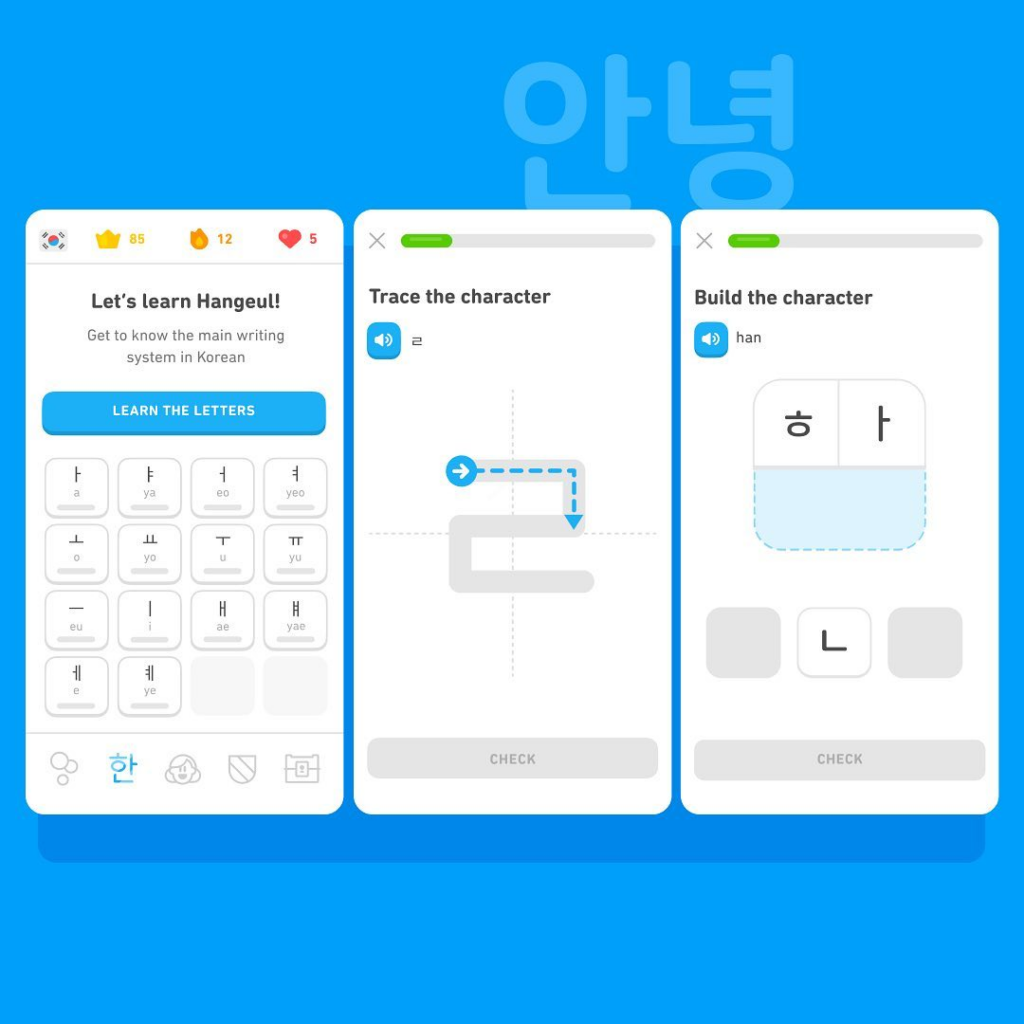
Image credit: @duolingo via Instagram
Duolingo is one of the top language learning apps with a colourful interface and easy-to-use features to help you learn a new language.
No matter whether you are a beginner or intermediate learner, Duolingo can match your level and learning pace.
The app includes fun and useful features such as lessons, games and challenges to help you practise Korean by speaking, listening and writing.
Download Duolingo on iOS | Android.
2. Drops
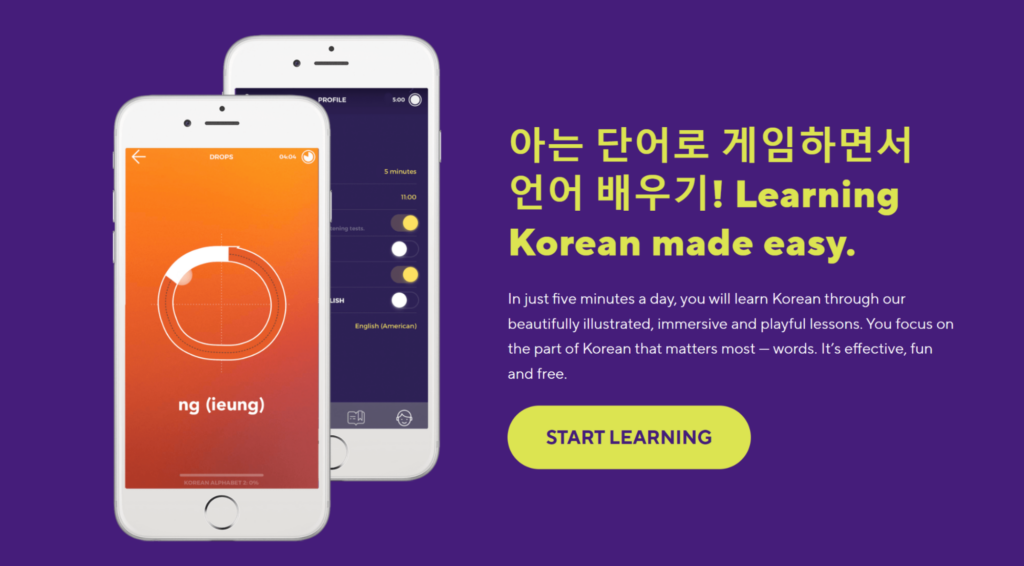
Image adapted from: Drops
Drops is another helpful app to help you learn Korean, especially for vocabulary. They have a specially curated Korean word list covering many topics.
Drops focuses heavily on using interesting and nicely drawn graphics to support the learning and memorising of new words.
Download Drops on iOS | Android.
3. LingoDeer
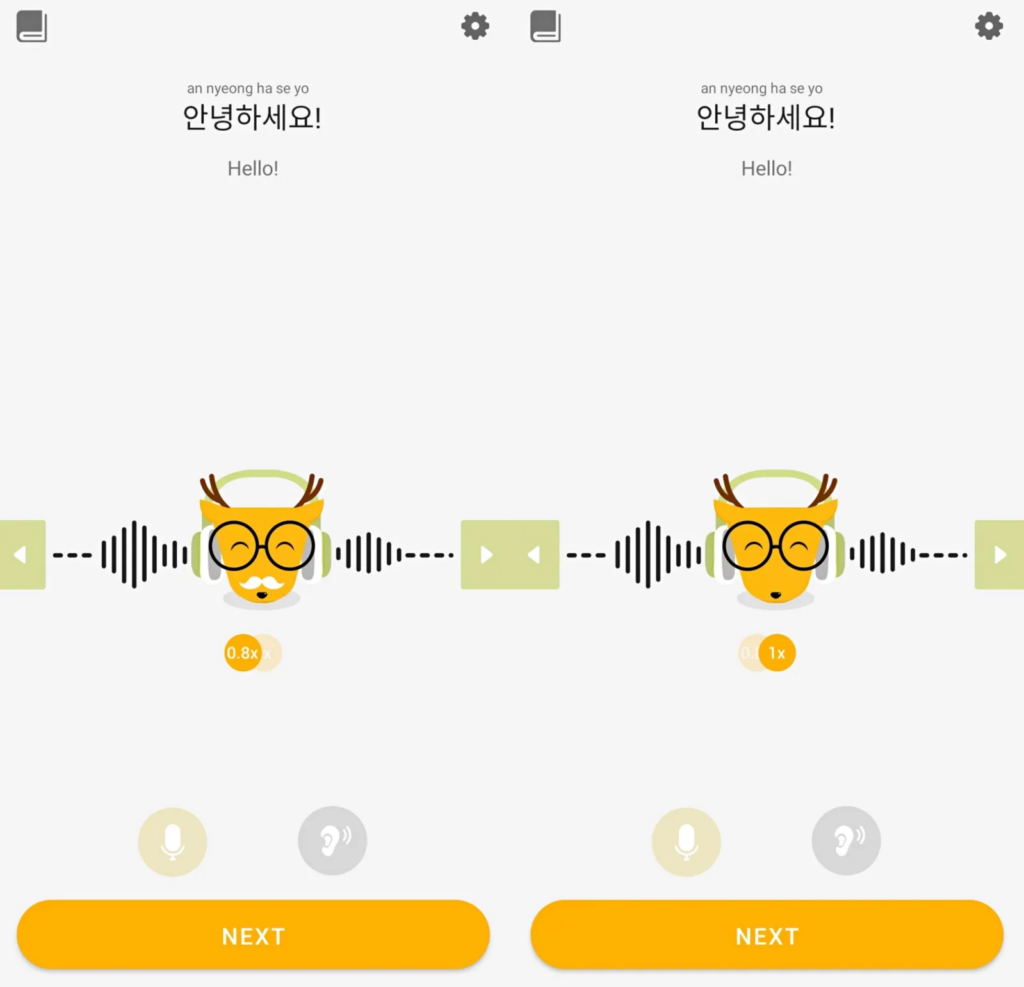
Image credit: LingoDeer
LingoDeer is another reliable app for learning Korean. It has many features that make learning Korean much more manageable.
To improve your listening and pronunciation, you can listen to their pre-recorded audio files that are done by native speakers.
A great thing about LindoDeer is that they allow you to listen to the audio at slower speeds, making it easier for you to catch the pronunciation.
You can also set your personal targets and track your learning progress on the app.
Download LingoDeer on iOS | Android.
– Apps that allow you to start conversations with native speakers –
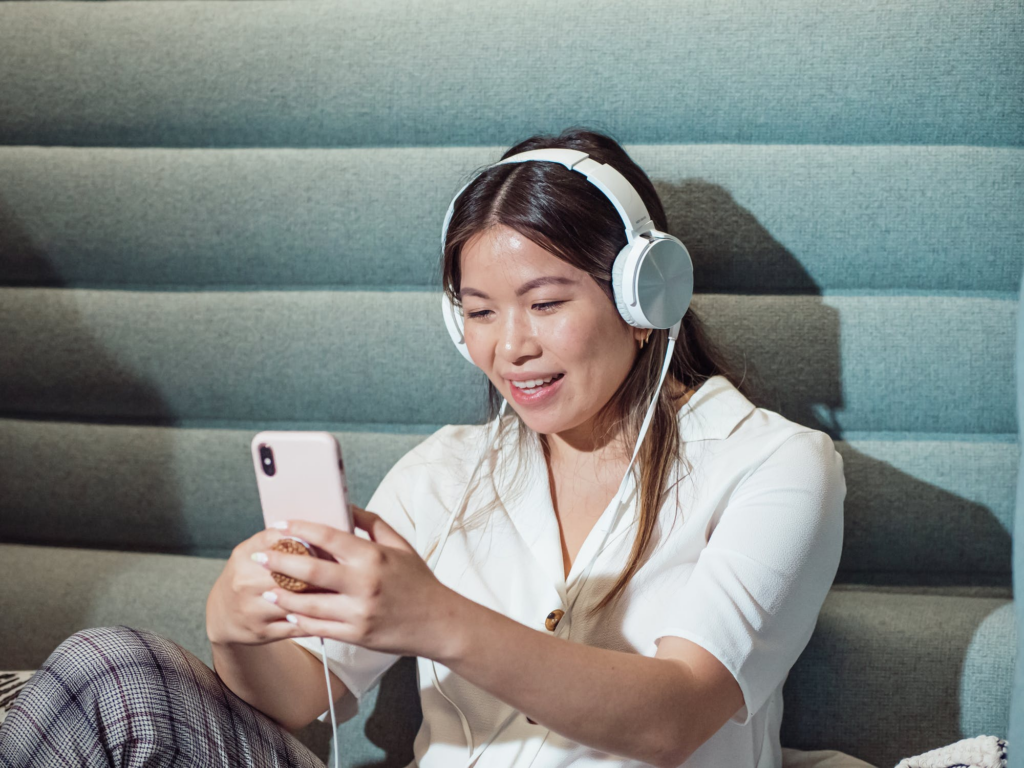
Image credit: Kindel Media via Pexels
It is hard to start a conversation or form a proper sentence in a language you are not fluent in. But the hard truth is that you can only improve if you speak and use the language.
Here are some apps that will help you practise Korean by starting conversations with native speakers who might want to learn a language that you are fluent in.
1. HelloTalk
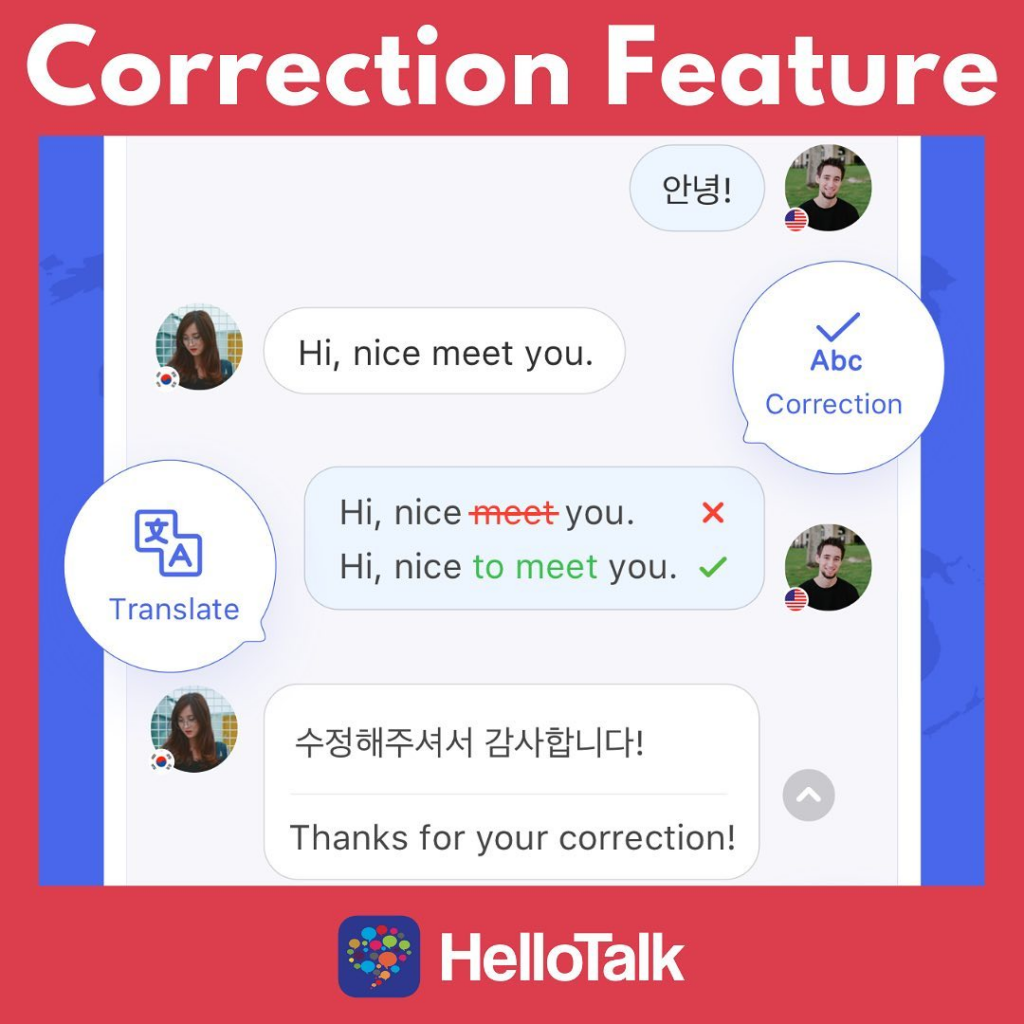
Image credit: @hellotalkofficial via Instagram
The HelloTalk app has many features that will make it easier for you to learn Korean.
The app provides a platform and a community where you can find language exchange partners to chat with.
Other than the chatting feature, HelloTalk has the correction feature that will allow you or your learning partner to correct each other’s message whenever a mistake is spotted.
Your language exchange partner’s messages can be translated from Korean to English so that you can understand the messages and recognise the Korean characters.
Voice messages can also be transcribed to learn the pronunciation of the different Korean words.
Download HelloTalk on iOS | Android.
2. Tandem
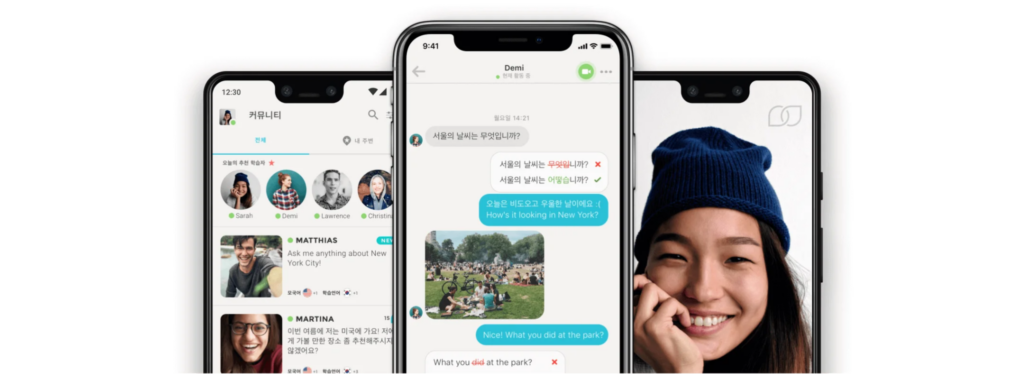
Image credit: Tandem
Like HelloTalk, Tandem is another app for you to communicate with native speakers of the language you are learning.
On the Tandem app, you can choose your language exchange partner based on the language you are learning, location, or even interests.
Besides the chat function with translation and correction features, you can also choose to video chat with your language exchange partner.
Download Tandem on iOS | Android.
3. Idyoma

Image credit: Idyoma
If you are worried about talking to chatbots or creepy people on language apps, Idyoma is the app for you.
Idyoma has a badge for users who have had their identity verified, so you can choose to connect with verified users only.
Another interesting feature of this app is that you can add your friends who are interested in learning Korean into the same group and learn together.
Download Idyoma on iOS | Android.
Beginners’ guide to how to learn Korean by yourself
Learning a new language by yourself can be challenging and demanding. The Korean language may seem complex to understand, but you can ace it with enough practice.
For more language-related content, check out these guides on how to distinguish the differences between Korean dialects, popular Korean texting slang words, Busan dialect phrases to learn, Korean phrases for travelling, and Korean phrases for ordering food at restaurants.
Cover image adapted from: Avel Chuklanov via Unsplash, Wes Hicks via Unsplash, @sbs_runningman_sbs via Instagram, ibmoon Kim via Unsplash
